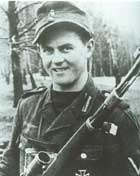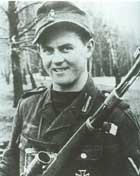Hetzenauer was born in Brixen im Thale, Austria. a rural area in the northern part Austria close to the German border. His father was Simon Hetzenauer and his mother, Magdalena. The family was consider to be of "peasant stock" and survived on what they grew and the game they killed. The elder Hetzenauer taught his son too hunt and developed him into an excellent shot that provided many meals for the family as he got older. His hunting skills were honed during his youth and he learned to patiently wait for his target to present itself and the importance of using camouflage so as to not be detected by his prey - skills that served him well in the coming World War. He was drafted into the German Army at age 17, serving time in a couple of different units. Then Hetzenauer trained as a sniper starting from March 27 through July 16, 1944. Upon completion of his training, he was assigned the the 3rd Gebirgsjäger (Mountain) Division as a Gefreiter (Private). He was issued two rifles; a K98 Mauser with a six power scope and a Gewehr 43 with a four power scope. He performed his duty as a sniper with great stealth and proficiency. Hetzenauer seemed to specialize in killing Soviet officers and machine-gun crews. On several occasions he was teamed up with fellow Austrian sniper Josef "Sepp" Allerberger and together had over 600 kills. On November 16, 1944 while in position, he was wounded in the head by Soviet artillery and awarded the Wound Badge (like the United States Purple Heart) three days later. Hetzenauer received the Knight's Cross of the Iron Cross (roughly equivalent to the Medal of Honor) on April 17, 1945, due to his work as a sniper on the Russian Front. Generalleutnant Paul Klatt had recommended Hetzenauer because of his numerous sniper kills, (approximately 345 confirmed kills by war's end - all within 10 months) which equaled killing two (2) companies of enemy troops without fear for his own safety and while under enemy attack. His longest shot was estimated to have been 1100 meters. This prestigious recommendation was approved by General Karl von Le Suire and General der Panzertruppe Walter Nehring. Just before the war ended in May, 1945, Hetzenauer was captured by the Soviet Army and imprisoned as a prison of war. Like most German soldiers captured by the Soviets, he served five years under deplorable conditions before he was released and allowed to return home to Austria where he died at age 79 after years of deteriorating health. Hetzenauer received the following awards for his service in the German Army during World War II:
Knight's Cross of the Iron Cross
Iron Cross 1st Class
Iron Cross 2nd Class
Wound Badge in Gold
Infantry Assault Badge in silver
Sniper's Badge in Gold (only recipient)
Close Combat Clasp in gold
Russian Front Medal
Hetzenauer was born in Brixen im Thale, Austria. a rural area in the northern part Austria close to the German border. His father was Simon Hetzenauer and his mother, Magdalena. The family was consider to be of "peasant stock" and survived on what they grew and the game they killed. The elder Hetzenauer taught his son too hunt and developed him into an excellent shot that provided many meals for the family as he got older. His hunting skills were honed during his youth and he learned to patiently wait for his target to present itself and the importance of using camouflage so as to not be detected by his prey - skills that served him well in the coming World War. He was drafted into the German Army at age 17, serving time in a couple of different units. Then Hetzenauer trained as a sniper starting from March 27 through July 16, 1944. Upon completion of his training, he was assigned the the 3rd Gebirgsjäger (Mountain) Division as a Gefreiter (Private). He was issued two rifles; a K98 Mauser with a six power scope and a Gewehr 43 with a four power scope. He performed his duty as a sniper with great stealth and proficiency. Hetzenauer seemed to specialize in killing Soviet officers and machine-gun crews. On several occasions he was teamed up with fellow Austrian sniper Josef "Sepp" Allerberger and together had over 600 kills. On November 16, 1944 while in position, he was wounded in the head by Soviet artillery and awarded the Wound Badge (like the United States Purple Heart) three days later. Hetzenauer received the Knight's Cross of the Iron Cross (roughly equivalent to the Medal of Honor) on April 17, 1945, due to his work as a sniper on the Russian Front. Generalleutnant Paul Klatt had recommended Hetzenauer because of his numerous sniper kills, (approximately 345 confirmed kills by war's end - all within 10 months) which equaled killing two (2) companies of enemy troops without fear for his own safety and while under enemy attack. His longest shot was estimated to have been 1100 meters. This prestigious recommendation was approved by General Karl von Le Suire and General der Panzertruppe Walter Nehring. Just before the war ended in May, 1945, Hetzenauer was captured by the Soviet Army and imprisoned as a prison of war. Like most German soldiers captured by the Soviets, he served five years under deplorable conditions before he was released and allowed to return home to Austria where he died at age 79 after years of deteriorating health. Hetzenauer received the following awards for his service in the German Army during World War II:
Knight's Cross of the Iron Cross
Iron Cross 1st Class
Iron Cross 2nd Class
Wound Badge in Gold
Infantry Assault Badge in silver
Sniper's Badge in Gold (only recipient)
Close Combat Clasp in gold
Russian Front Medal



